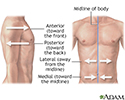Lateral traction
Lateral traction is a treatment technique in which weight or tension is used to move a body part to the side or away from its original location.
Information
Traction can be used to treat or reduce any joint dislocation or bone fracture by applying tension to the leg or arm with weights and pulleys to realign the bone. For example, it may be used to help keep a dislocated hip within the hip socket while it heals.
Traction
Traction means pulling on part of the body. Most often, traction uses devices such as weights and pulleys to put tension on a displaced bone or joint...
Dislocation
A dislocation is a separation of 2 bones where they meet at a joint. Joints are areas where 2 bones come together. A dislocated joint is a joint whe...

Traction as a treatment involves the amount of tension or force used, the length of time the tension is used, and the means used to maintain the tension. Lateral traction can also be used to treat some broken bones.
References
Browner BD, Jupiter JP, Krettek C, Anderson PA. Closed fracture management. In: Browner BD, Jupiter JP, Krettek C, Anderson PA, eds. Skeletal Trauma: Basic Science, Management, and Reconstruction . 5th ed. Philadelphia, PA: Elsevier Saunders; 2015:chap 6.
Thompson SR. Tibial skeletal traction. In: Thompson SR, Zlotolow DA, eds. Handbook of Splinting and Casting . Philadelphia, PA: Elsevier Mosby; 2012:chap 16.
-
Lateral orientation - illustration
A lateral orientation is a position away from the midline of the body. For instance, the arms are lateral to the chest, and the ears are lateral to the head. A medial orientation is a position toward the midline of the body. An example of medial orientation is the eyes, which are medial to the ears on the head.
Lateral orientation
illustration
-
Lateral orientation - illustration
A lateral orientation is a position away from the midline of the body. For instance, the arms are lateral to the chest, and the ears are lateral to the head. A medial orientation is a position toward the midline of the body. An example of medial orientation is the eyes, which are medial to the ears on the head.
Lateral orientation
illustration
Review Date: 5/9/2015
Reviewed By: C. Benjamin Ma, MD, Assistant Professor, Chief, Sports Medicine and Shoulder Service, UCSF Department of Orthopaedic Surgery, San Francisco, CA. Also reviewed by David Zieve, MD, MHA, Isla Ogilvie, PhD, and the A.D.A.M. Editorial team.

